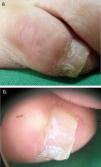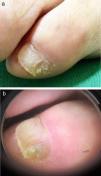A 44-year-old man visited our department with prominences on both sides of the fifth toe, which had appeared following a walk, on which he had worn tight footwear. The patient complained of discomfort only when pressure was applied to this area. Physical examination revealed external rotation of the fifth toe and increased width of the nail plate on both small toes. Each of these nails was also covered by cuticle, divided by a longitudinal cleft, and the nail plate showed lateral thickening (Fig. 1A and Fig. 2A). Dermatoscopy confirmed that the nail consisted of 2 clearly demarcated parts (Fig. 1, Fig. 2, and Fig. 2B). The patient was not aware of this abnormality in any family member. A simple anteroposterior and lateral x-ray of both feet was requested and ruled out the presence of accessory phalanges or other bone abnormalities (Fig. 3). No treatment was indicated, other than reduction of the direct trauma.
The double nail of the fifth toe (DNFT) or accessory nail of the fifth toe was described in 1969 by Huindeker and is an apparently common entity, although few published cases exist.1–4
The most common clinical presentation is the appearance of a wider-than-normal nail divided by a longitudinal cleft, fold, or depression, and the part corresponding to the accessory nail is smaller. A cuticle covers both nail plates in the proximal area of the nail. DNFT may be unilateral or bilateral, and when both toes are affected there tends to exist considerable symmetry.3,4 Clinical or aesthetic problems due to the size of the nail occur only occasionally.3,4
It is rare to find abnormalities in the x-ray of the fifth toe. Of 10 x-rays performed in 1 series, only 3 patients presented a lazy Y on the tip of the distal phalanx, and another patient presented a thorn-like bony excrescence.4 A Y-shaped tip of the terminal phalangeal bone was identified during surgery in 2 patients.4
DNFT was initially thought to be a hereditary process limited to the Han ethnic group, the largest ethnic group in China.3 Haneke, however, found that the entity showed no racial or ethnic predilection.4 Autosomal dominant heredity with variable expression has been proposed.4 Familial cases show no clear predisposition by sex, although women consult more for this abnormality.5,6 DNFT may represent an initial form of hexadactyly, which would give rise to a rudimentary nail.4 Acute trauma may act on vestigial bone, inducing the appearance of a nail or on the onychodermis which, as specialized nail mesenchyma, would lead to nail formation and growth. The onychodermis is made up of onychofibroblasts and takes part in nail formation and growth.7
The histology of excised accessory nails varies from a depression like a sack of skin with hyperkeratosis like a nail plate, to a small nail with a matrix, proximal fold, nail bed, and hyponychium.5,6
The differential diagnosis is established with ectopic nail, postoperative spiculated nail, onychophosis, or callus of the fifth toe. Ectopic nail or onychoheterotopia refers to growth of a nail outside the nail bed. It may be congenital or be associated with other diseases, and it is most frequent on the palmar region of the fingers. The acquired form is located on the dorsal region of the fingers and toes. Ectopic nails must have a matrix and nail plate but do not require a nail bed.8 Onychophosis is a hyperkeratosis of the lateral folds of the nail triggered by frequent trauma to that area, which causes hypertrophy and thickening of the skin surrounding the nail. Calluses or corns on the external surface of the fifth toe consist of hyperkeratosis caused by repeated rubbing of footwear and are usually accompanied by intense pain.
DNFT does not usually require treatment. If desired, phenolization of the accessory matrix or surgical excision of the accessory nail may be performed. Excision of DNFT allows for a better view and excision of the matrix, facilitates repair of the defect remaining after removing the accessory nail, and faster recovery than with other treatments. Curettage and electrocoagulation are not recommended because of the prolonged scarring process and the intense postoperative pain.3
In conclusion, we present a case of bilateral double nail of the fifth toe, which developed following acute trauma. This entity is considered to be common, not rare, and tends to go unnoticed. Further studies are required to determine the etiology of the entity.
Conflicts of InterestThe author declares that he has no conflicts of interest.
The author would like to thank Dr. Eckart Haneke for the clinical assessment of the presented case.
Please cite this article as: Navarro Campoamor L. Doble uña del quinto dedo del pie. Actas Dermosifiliogr. 2021;112:188–190.












